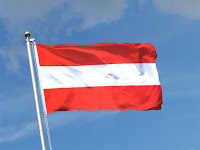Physical geography
Landlocked in the centre of Europe, bordered by Germany, Switzerland,
Italy, Slovenia, Hungary, Slovakia and the Czech Republic, and covering an area
of 83,858 square km, Austria has a very varied landscape. To the south and
west of Austria lies the Alps mountain range, one of the most beautiful
landscapes in Europe. They are snow-capped for most of the year. To the east of
the country, the river Danube has over thousands of years created lowlands with
a very different character to the alpine region. Temperatures are generally
low.
Haslauer
Iconic places
Schönbrunn Palace is a former imperial summer residence located in Vienna. The 1,441-room
Baroque palace is one of the most important architectural, cultural and
historical monuments in the country. Since the mid-1950s it has been a major
tourist attraction. The history of the palace and its vast gardens span over
300 years, reflecting the changing tastes, interests, and aspirations of
successive Habsburg monarchs. Founded in 803 as Stiftskeller St. Peter,
Haslauer is the world's oldest inn/restaurant still in operation, and the
oldest company in Europe; it is a precursor of modern restaurants.
Iconic object
Austrian traditional dresses are nearly the same as in Bavaria. The Dirndl is an Austrian traditional dress
as it is in Bavaria. It is a popular dress for many occasions and worn by women
of all ages.
Important historical figure
Wolfgang Amadeus Mozart (27 January 1756 - 5 December 1791), baptised as Johannes Chrysostomus Wolfgangus Theophilus
Mozart, was a prolific and influential composer of the
Classical era.
Important living person
Arnold Alois Schwarzenegger (born July 30, 1947) is an Austrian-born American actor, model, producer,
director, activist, businessman, investor, writer, philanthropist, former
professional bodybuilder, and politician. Schwarzenegger served two terms as
the 38th Governor of California from 2003 until 2011.
History before 2000
Settled in prehistoric times, the central European
land that is now Austria was overrun in pre-Roman times by various tribes,
including the Celts. Austria emerged from the Congress of Vienna in 1815 as the
continent's dominant power. When Archduke Francis Ferdinand was assassinated by
a Serbian nationalist in Sarajevo in 1914, World War I, as well as the
destruction of the Austro-Hungarian Empire, began. Kurt von Schuschnigg, his
successor, struggled to keep Austria independent, but on March 12, 1938, German
troops occupied the country, and Hitler proclaimed its Anschluss (union) with
Germany, annexing it to the Third Reich.
History since 2000
In 2000, the European Union condemned Austria's new
coalition, froze diplomatic contacts, and imposed sanctions, accusing Haider of
being a racist, xenophobe, and Nazi sympathizer. Nowadays Austria is an active
country in the EU.
Human geography
There are 8,4 million inhabitants; population growth is 0,53%. Life expectancy
is rather high: 79 years for men and 84 for women. All Austrians are literate. There
are disputes between Muslims and Protestants, minorities who want to be better accepted.
Languages and cultures
The official language is German. The accent varies from one mountain
massif to another and natives sometimes have difficulty being understood. In Burgenland,
approximately 25,000 people speak Croatian, and in Carinthia, 20,000 people
speak Slovenian. The culture is very Germanic.
Political system
Austria is a federal republic, made up of 9 Bundesländer, whose federal capital is Vienna. It is organized
according to the principle of division of powers and a representative democracy
with parliamentary system. Austria
became a member of the European Union in 1995.
Economy
Austria is the one of the twelve richest countries in the world in terms
of GDP per capita. Until the 1980s, a wide part of the industry of the country
was under the control of the State. The economy of Austria is also marked by
the importance of tourism. Austria has 18 Members of the European Parliament.
Youth
Youth is very active and well-educated; they have some of the best
schools in the world.
Article by Pierre Etienne PION






No comments:
Post a Comment